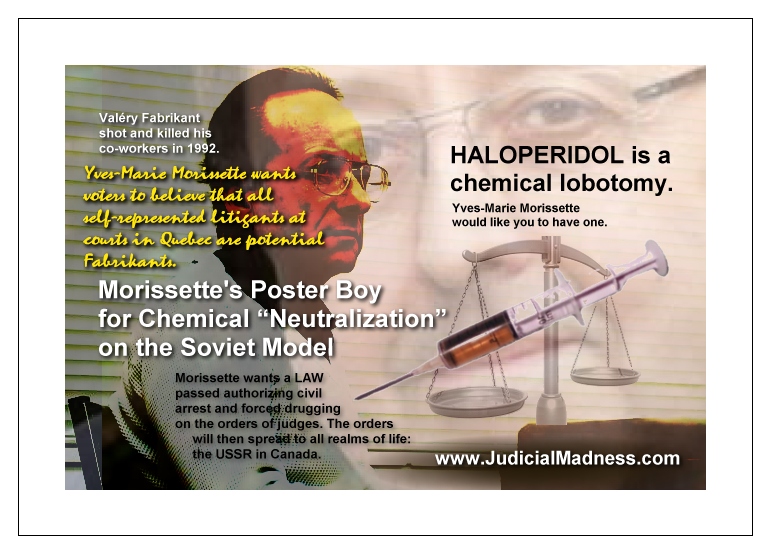Morin v N.S.H.U.R.C., [1985] 2 SCR 662
WARNING
|
Morin v National Special Handling Unit Review Committee, [1985] 2 SCR 662
Source: https://scc-csc.lexum.com/scc-csc/scc-csc/en/item/107/index.do
Supreme Court Judgments
Case name: Morin v. Shu Review Committee
Collection: Supreme Court Judgments
Date: 1985-12-19
Report: [1985] 2 SCR 662
Case number: 17336
Judges: Dickson, Robert George Brian; Beetz, Jean; Estey, Willard Zebedee; McIntyre, William Rogers; Lamer, Antonio; Wilson, Bertha; Le Dain, Gerald Eric
On appeal from: Quebec
Subjects: Prerogative writs
Notes: SCC Case Information: 17336
Morin v. Shu Review Committee, [1985] 2 S.C.R. 662
Réjean Morin Appellant;
and
National Special Handling Unit Review Committee, D. Yeomans and P. Goulem Respondents;
and
Bob Kaplan Mis en cause.
File No.: 17336.
1984: October 12; 1985: December 19.
Present: Dickson C.J. and Beetz, Estey, McIntyre, Lamer, Wilson and Le Dain JJ.
on appeal from the court of appeal for quebec
Prerogative writs ‑‑ Habeas corpus ‑‑ Jurisdiction ‑‑ Superior courts ‑‑ Inmate confined in a special handling unit ‑‑ Application for habeas corpus in superior court ‑‑ Whether a provincial superior court has jurisdiction to issue a writ of habeas corpus to determine the validity of an inmate’s confinement in a special handling unit of a federal penitentiary ‑‑ Federal Court Act, R.S.C. 1970 (2nd Supp.), c. 10, s. 18.
Following the death of a fellow inmate, appellant was charged with murder and confined to a special handling unit in another institution. A special handling unit is a facility established to deal exclusively with inmates who, in addition to requiring maximum security, are identified as being particularly dangerous. Despite his acquittal of the charge of murder, appellant was kept in segregation and his request to be transferred back to a medium security institution refused. He then applied to the Superior Court for a writ of habeas corpus without certiorari in aid to obtain his release from the special handling unit. Considering the exclusive jurisdiction of the Federal Court under s. 18 of the Federal Court Act to issue certiorari against any federal board, commission or other tribunal and the limits of the role of habeas corpus, the court dismissed appellant’s application for want of jurisdiction to issue a writ of habeas corpus in these circumstances. The Court of Appeal concluded that proceedings attacking the internal administrative procedure of penitentiaries were within the exclusive competence of the Federal Court of Canada and affirmed the judgment.
Held: The appeal should be allowed.
For the reasons given in R. v. Miller, [1985] 2 S.C.R. 613, a provincial superior court has jurisdiction to issue a writ of habeas corpus to determine the validity of the confinement of an inmate of a federal penitentiary in a special handling unit notwithstanding that the same issue may be determined upon certiorari in the Federal Court. The proper scope of the availability of habeas corpus must be considered first on its own merits, apart from possible problems arising from concurrent or overlapping jurisdiction.
Cases Cited
R. v. Miller, [1985] 2 S.C.R. 613, followed; Cardinal v. Director of Kent Institution, [1985] 2 S.C.R. 643; Berrouard v. The Queen, S.C. Longueuil, No. 505‑01‑001299‑789, November 30, 1981; Mitchell v. The Queen, [1976] 2 S.C.R. 570, referred to.
Statutes and Regulations Cited
Federal Court Act, R.S.C. 1970 (2nd Supp.), c. 10, s. 18.
Penitentiary Service Regulations, C.R.C. 1978, c. 1251, s. 40.
APPEAL from a judgment of the Quebec Court of Appeal, [1982] C.A. 464, 142 D.L.R. (3d) 582, 1 C.C.C. (3d) 438, affirming a judgment of the Superior Court dismissing appellant’s application for habeas corpus. Appeal allowed.
Renée Millette, for the appellant.
Jacques Letellier, Q.C., and Richard Starck, for the respondents and mis en cause.
The judgment of the Court was delivered by
1. Le Dain J.‑‑The issue in this appeal is whether, having regard to the role of habeas corpus and the exclusive jurisdiction of the Federal Court of Canada by way of certiorari to review the administrative decisions of federal authorities, a provincial superior court has jurisdiction to issue a writ of habeas corpus to determine the validity of the confinement of an inmate of a federal penitentiary in a “special handling unit”, a particularly restrictive form of segregated detention, and if such confinement be found to be unlawful, to order his release or transfer to another form of detention within the federal penitentiary system.
2. The appeal is by leave of this Court from the judgment of the Quebec Court of Appeal on June 17, 1982 dismissing the appeal from the judgment of Bergeron J. of the Superior Court for the District of Montreal on November 18, 1981, which dismissed the appellant’s application for habeas corpus to determine the validity of his confinement in the Special Handling Unit of the Centre for Correctional Development, a federal institution at Laval, Quebec, on the ground that the Court lacked jurisdiction.
3. The following statement of the facts is based on the allegations of the appellant’s application for habeas corpus, supported by affidavit, and the documents produced as exhibits with the application. The appellant was lawfully confined in Leclerc Institution, a medium‑security federal penitentiary, when a fellow inmate, Claude Payeur, was killed on September 21, 1980 following a quarrel with another inmate, Serge Cousineau. The following day the appellant was transferred to Laval Institution, a maximum‑security federal penitentiary, where he was placed in segregation. On September 25, 1980 a coroner’s inquest, at which the appellant and Cousineau were called to testify, found that Payeur had met a violent death for which Cousineau was responsible. On October 2, 1980 the appellant was charged with the murder of Payeur. On December 5, 1980 he was transferred to the Special Handling Unit of the Centre for Correctional Development at Laval. In a letter of December 15, 1980 the Director of the Centre informed the appellant that his confinement in the Special Handling Unit had been recommended by a regional committee and approved by the National SHU Review Committee [TRANSLATION] “as a result of your being charged with the murder of an inmate at Leclerc”. The appellant was acquitted on May 30, 1981 of the murder of Claude Payeur after a trial of several days before Bergeron J. sitting with a jury. On June 1, 1981 the appellant lodged an inmate complaint in which he asked, as a result of his acquittal, to be released from the Special Handling Unit and transferred to a medium‑security institution. His case was reviewed by the National SHU Review Committee, before which he appeared on July 16, 1981. A letter dated August 11, 1981 from D. R. Yeomans, Commissioner, to counsel for the appellant contained the following passages with reference to the appellant’s confinement in the Special Handling Unit and the National Committee’s review of his case:
[TRANSLATION] Mr. Morin was transferred to the Special Handling Unit of the Centre for Correctional Development by authority of the Deputy Commissioner, Security, in accordance with section 13(3) of the Penitentiary Act. Mr. Morin had been identified as a particularly dangerous inmate after he participated in an incident during which another inmate was killed.
The National SHU Review Committee is aware of the fact that Mr. Morin was acquitted of the charge of murder against him. However, the Committee considers that Mr. Morin still constitutes a danger to the other inmates and it has asked for the police reports on the incident. I understand your wish to see Mr. Morin transferred to another institution, but before doing so the National Committee must ensure that he does not constitute a danger to others and will not be involved in a similar incident in the immediate or distant future.
4. By letter of September 10, 1981 from J. U. M. Sauvé, Deputy Commissioner, Security, the appellant was informed of the review of his case by the National SHU Review Committee and the resulting decision to continue his confinement in the Special Handling Unit, despite his acquittal, as follows:
[TRANSLATION] At the review of your case in July 1981 the SHU Committee informed you that your case would be re‑examined on receipt of a police report regarding your involvement in the murder of the inmate Payeur.
The Committee has now received the documentation confirming that the charge against you was based on a before‑death statement by the victim and another statement given to police investigators by a witness. These information sources identified you as taking part in the murder. The Committee was also told that the Crown will appeal the judgment rendered in your case.
Accordingly, the decision to transfer you to a Special Handling Unit was based on the criteria indicated in paragraph 4 of Commissioner’s Directive No. 274, and remains unchanged.
5. On October 28, 1981 the appellant applied to the Superior Court for the District of Montréal for a writ of habeas corpus without certiorari in aid to obtain his release from the Special Handling Unit and his transfer to Leclerc Institution on the ground that his continued confinement in the Special Handling Unit following his acquittal of the charge of murder for the reasons indicated in the letters quoted above was unlawful. The appellant contended that the decision to continue his confinement in the Special Handling Unit, which he attributed to the National SHU Review Committee, was made without jurisdiction because it amounted to an appellate reversal of his acquittal or a retrial on the charge of murder and was contrary to ss. 4 and 8 of Commissioner’s Directive 274 of December 1, 1980 with respect to special handling units.
6. Commissioner’s Directive 274 defines “Special Handling Unit” as follows:
“Special Handling Unit” (SHU) is a facility established to deal exclusively with inmates who, in addition to requiring maximum security, have been identified as being particularly dangerous.
7. Section 4 of the Directive defines “Particularly dangerous inmate” as follows:
“Particularly dangerous inmate” is one whose documented actions or demonstrated intentions while in custody in any jurisdiction, or under sentence, constitute a persistent and serious threat to staff, inmates or other persons. Such conduct includes, but is not limited to, one or more of the following:
a. abduction, hostage‑taking, forcible confinement or attempts;
b. serious incidents of violence;
c. escape or attempted or planned escape with violence;
d. conviction for the murder of a peace officer, inmate or other person while under sentence;
e. the manufacture, possession, introduction, or attempted introduction into an institution of firearms, ammunition, high explosives or any offensive weapon, as defined in the Criminal Code ;
f. incitement or conspiracy to kill or riot; and
g. substantiated serious threats against the life of a staff member, inmate or other person.
8. Section 8 of the Directive provides:
8. The prime consideration for transfer of an inmate to an SHU shall be that he is assessed to be particularly dangerous and, therefore, prejudicial to the maintenance of good order in the institution. Inmates shall not be transferred to an SHU on suspicion alone. Reasonable and probable grounds for believing an inmate intends or is likely to commit a violent or dangerous act must be supported by documentation.
9. The authority of the Deputy Commissioner, Security, with respect to confinement in a Special Handling Unit is referred to in the definition of “National SHU Review Committee” in s. 6 of the Directive as follows:
6. The “National SHU Review Committee” consist of the Deputy Commissioner, Security, as chairman, the Deputy Commissioner Offender Programs, the Director General Medical Services and senior regional representatives from the receiving and sending regions as specified by the Regional Director General. The Deputy Commissioner Security is delegated the authority, pursuant to section 13(3) of the Penitentiary Act, to authorize the transfer of inmates into and out of an SHU.
II
10. As the judge who had conducted the trial of the appellant on the charge of murder, Bergeron J. of the Superior Court expressed the opinion that the continued confinement of the appellant in the Special Handling Unit, despite his acquittal, for the reasons indicated in the letters quoted above was without foundation and in violation of the rules of natural justice and fairness. He dismissed the application for habeas corpus, however, on the ground that the Superior Court lacked jurisdiction to issue a writ of habeas corpus to determine the validity of the confinement of an inmate of a federal penitentiary in a special handling unit. As I read his reasons for judgment, he based this conclusion on two considerations: (a) the exclusive jurisdiction of the Federal Court of Canada under s. 18 of the Federal Court Act, R.S.C. 1970 (2nd Supp.), c. 10, to issue certiorari against any federal board, commission or other tribunal; and (b) the limits of the role of habeas corpus. After referring to the judgment of McEachern C.J.S.C in Cardinal v. Director of Kent Institution (S.C.B.C., December 30, 1980) holding that habeas corpus would lie to release an inmate of a federal penitentiary from administrative dissociation or segregation, as from a “prison within a prison”, into normal association with the general inmate population of the penitentiary, Bergeron J. said:
[TRANSLATION] With the utmost respect for the opinion expressed in [Cardinal], I consider that the rules applicable in the review of administrative decisions by prison authorities fall within the ambit of ss. 18 and 28 of the Federal Court Act, R.S.C. 1970 (2nd Supp.), c. 10: the situation is not devoid of a remedy, as certiorari is open to the applicant within the limits of the Federal Court’s jurisdiction to correct an emerging situation, either of an absence of fairness or of a denial of natural justice.
Further, in the same volume [The Law of Habeas Corpus (1976)], at p. 147, the writer Sharpe mentions the approach consistently taken by the common law courts and their reluctance to become involved in disciplinary matters in the exercise of their inherent jurisdiction, noting the use of certiorari in this regard to obtain remedies capable of remedying emerging situations of abuse of jurisdiction, which could deprive a person of certain of his rights as an inmate.
I adopt the latter view, as I consider that the conditions of detention cannot be a basis for a writ of habeas corpus where the individual is otherwise legally imprisoned under a valid warrant of committal, beyond which the Superior Court cannot go.
11. The unanimous judgment of the Quebec Court of Appeal dismissing the appeal from the judgment of Bergeron J. is reported at [1982] C.A. 464 and (1982), 142 D.L.R. (3d) 582, 1 C.C.C. (3d) 438 (sub nom. Re Morin and Yeomans). Turgeon J.A., with whom Nolan and Malouf JJ.A. concurred, considered the exclusive jurisdiction by way of certiorari of the Federal Court, the unreported judgments of Hugessen A.C.J. (as he then was) in Berrouard v. The Queen, S.C. Longueuil, No. 505‑01‑001299‑789, November 30, 1981, and related cases in which he held that habeas corpus will not lie to release an inmate from a particular form of detention if he will remain subject to lawful detention in another form, and the opinion of Ritchie J. in Mitchell v. The Queen, [1976] 2 S.C.R. 570, that on an application for habeas corpus a court is confined to consideration of the warrant of committal. He expressed concern about the possibility of conflicting judgments if habeas corpus issued because the appellant had, following the refusal of habeas corpus by the Superior Court, challenged the validity of his continued confinement in the Special Handling Unit by an application for certiorari in the Federal Court. He concluded on the question of jurisdiction as follows:
[TRANSLATION] For all these reasons, I find that proceedings attacking the internal administrative procedure of penitentiaries are within the exclusive competence of the Federal Court of Canada.
III
12. The sole issue in this appeal is the question of the jurisdiction of a provincial superior court to issue a writ of habeas corpus to determine the validity of the confinement of an inmate of a federal penitentiary in a special handling unit. No argument was addressed to the question whether, assuming the habeas corpus would lie in such a case, the appellant’s grounds of attack on the validity of his continued confinement in the Special Handling Unit at Laval fell within the scope of review on habeas corpus, nor was argument addressed to the merits of those grounds of attack. Moreover, the question of jurisdiction itself has long since become academic by the appellant’s transfer out of the Special Handling Unit, but because of its general importance the Court considers that it should pronounce on it.
13. The issue of jurisdiction in this appeal was also before this Court, at least by implication, in R. v. Miller, [1985] 2 S.C.R. 613, and Cardinal v. Director of Kent Institution, [1985] 2 S.C.R. 643, which were heard at the same time as this appeal. In those cases the principal question of jurisdiction was whether, in view of the exclusive jurisdiction of the Federal Court of Canada under s. 18 of the Federal Court Act to issue certiorari against any federal board, commission or other tribunal, a provincial superior court had jurisdiction to issue certiorari in aid of habeas corpus to determine the validity of the confinement of an inmate of a federal penitentiary in a special handling unit or in administrative dissociation or segregation, pursuant to s. 40 of the Penitentiary Service Regulations, C.R.C. 1978, c. 1251. The question of jurisdiction to issue habeas corpus alone for such purpose was also put in issue, but perhaps not as directly in relation to the jurisdiction of the Federal Court as it was in the reasons of the Superior Court and the Court of Appeal in the case at bar. In the other appeals this issue was presented more directly, if not exclusively, in terms of the proper role or object of habeas corpus, quite apart from the jurisdiction of the Federal Court, the contention being that habeas corpus will not lie to release a prisoner from a particular form of confinement if he will remain otherwise lawfully detained in another form. In the course, however, of the reasons for judgment on this issue in R. v. Miller the Court gave consideration to the implications of such a use of habeas corpus, having regard to the jurisdiction by way of certiorari of the Federal Court, and reference was made to the reasoning of the Superior Court and the Court of Appeal in the case at bar. The conclusion on this issue in R. v. Miller, was as follows (at pp. 640‑41):
After giving consideration to the two approaches to this issue, I am of the opinion that the better view is that habeas corpus should lie to determine the validity of a particular form of confinement in a penitentiary notwithstanding that the same issue may be determined upon certiorari in the Federal Court. The proper scope of the availability of habeas corpus must be considered first on its own merits, apart from possible problems arising from concurrent or overlapping jurisdiction. The general importance of this remedy as the traditional means of challenging deprivations of liberty is such that its proper development and adaptation to the modern realities of confinement in a prison setting should not be compromised by concerns about conflicting jurisdiction. As I have said in connection with the question of jurisdiction to issue certiorari in aid of habeas corpus, these concerns have their origins in the legislative judgment to leave the habeas corpus jurisdiction against federal authorities with the provincial superior courts. There cannot be one definition of the reach of habeas corpus in relation to federal authorities and a different one for other authorities. Confinement in a special handling unit, or in administrative segregation as in Cardinal, is a form of detention that is distinct and separate from that imposed on the general inmate population. It involves a significant reduction in the residual liberty of the inmate. It is in fact a new detention of the inmate, purporting to rest on its own foundation of legal authority. It is that particular form of detention or deprivation of liberty which is the object of the challenge by habeas corpus. It is release from that form of detention that is sought. For the reasons indicated above, I can see no sound reason in principle, having to do with the nature and role of habeas corpus, why habeas corpus should not be available for that purpose. I do not say that habeas corpus should lie to challenge any and all conditions of confinement in a penitentiary or prison, including the loss of any privilege enjoyed by the general inmate population. But it should lie in my opinion to challenge the validity of a distinct form of confinement or detention in which the actual physical constraint or deprivation of liberty, as distinct from the mere loss of certain privileges, is more restrictive or severe than the normal one in an institution.
14. These reasons are determinative of the issue in this appeal. The Superior Court had jurisdiction to issue a writ of habeas corpus to determine the validity of the continued confinement of the appellant, following his acquittal of the charge of murder, in the Special Handling Unit of the Centre for Correctional Development at Laval, Quebec. I would accordingly allow the appeal and set aside the judgments of the Court of Appeal and the Superior Court, but in view of the appellant’s transfer out of the Special Handling Unit I would not refer the application for habeas corpus back to the Surperior Court for determination.
Appeal allowed.
Solicitor for the appellant: Renée Millette, Montréal.
Solicitors for the respondents and the mis en cause: Jacques Letellier and Richard Starck, Montréal.
>
Save and organize search results from SCC and CanLII, get alerts.
Get started with Lexbox
>
Twitter Notices
Get real-time notices of new Supreme Court decisions via Twitter.
Follow Lexum on Twitter
Lexum
For 20 years now, the Lexum site has been the main public source for Supreme Court decisions.
Home
|
Important Notices
|
Contact Us
|
Français
Mailing List
RSS Feeds
Decisia by Lexum
Last modification date: 2015-12-29




